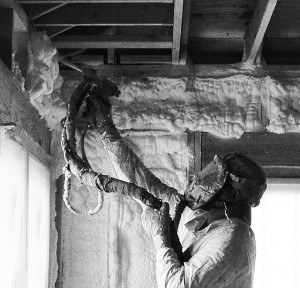 When building a house, spray foam insulation is one of those important factors that need to be considered carefully. Among the many options that are available, spray foam stands out as a long term alternative. Below is on overview of spray foam insulation and some installation tips.
When building a house, spray foam insulation is one of those important factors that need to be considered carefully. Among the many options that are available, spray foam stands out as a long term alternative. Below is on overview of spray foam insulation and some installation tips.
What Is Spray Foam Insulation?
Spray foam is a type of roofing insulation which is a synthetic substance which is produced by combining organic and inorganic materials. These materials can be made using different chemical combinations. One of these materials is created on-site by combining organic resin polyols & isocyonate at specific pressure and temperature conditions. The two compounds chemically react to create a polyurethane material. Polyurethane material can uniquely expand to a significantly large size.
After it has been applied, it takes about 4-hours for the form to harden. It fills out all the space in which it’s sprayed and generates a thermal blanket. When it is sprayed in concrete slabs, wall cavities, dry walls, and sheathing interior, it creates an effective insulation barrier.
The Purpose of Spray foam Insulation
After the installation, the created barrier against moisture build up and air flow takes care of both the insulation and mold growth problems. It strengthens a structure and insulates compact regions that are accessible to conventional foaming. Despite some health and environmental concerns that are raised as regards to these materials’ toxicity, they are safe to use if care is taken while they are being installed.
Some Installation Tips
Installation of spray foam insulation should be left to the professionals. This is majorly due to the fact that the materials that are used are hazardous in nature and the installation process requires special machinery. Below are some installation tips for people that decide to opt for this type of insulation.
• Research on the different spray foam products before making your final choice.
• Hire a licensed professional to perform the installation. Make sure the team that you hire is fully qualified for the job. The team should be able to install the spray foam according to the building code requirements of your local area. They should also be able to address any distinctive design features of your house. Inquire about their education qualifications and years of experience. Additionally, ask for customer references before making up your mind.
• Learn about the product. Spray foam is created using chemicals that are highly reactive. During the installation, contact must be avoided by using protective gear.
• Make a plan. For the best safety practices, there is a specific time for applying the spray foam and allowing it to cure. You should have a clear understanding of how long you need to be away from the house and length of time of the curing process.
• Learn about the installation process. Discuss it with your contractor so as to know how your home will be affected by the installation. Some of the important factors that you can discuss with your contractor include: safety practices, ventilation, as well as the required length of time for the installation.
The Pros of Spray foam Insulation
• It effectively seals cracks.
• Improves insulation’s quality.
• Prevents moisture buildup and lowers mold and mildew problems significantly.
• The adhesive property of the spray foam improves the strength of the building structure.
The Cons of Spray foam Insulation
• It’s pretty expensive.
• It must not be exposed to direct sunlight.
• Some people are allergic to the material.
Even though the cost of this type of insulation is greater than that for the other conventional alternatives, it is a profitable option if you consider the high savings on cooling and heating in the long term.